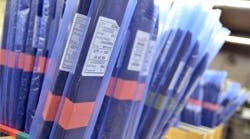Strings are assembled in 6 parallel cells.
Musical instrument strings used to be a byproduct of meat production. The roots of the D’Addario string plant lead to 17th century Salle, Italy, where raw material was really raw material. For strings it was sheep and hog intestines from butcher shops. The entrails were treated, twisted, and dried to make milady’s lute, harp, and violin strings. The result was lovely music arising from a very mundane source.
The D’Addario family began U.S. string production in the early 1900s. Today, the raw materials for musical instrument strings come from steel mills and oil wells, for nylon, so the beauty of music still arises from some gritty sources. The alchemy of this conversion happens on its greatest scale on Long Island, in Farmingdale, New York. The D’Addario string plant there produces about 700,000 strings per working day. The strings, some built from up to a dozen different wires, emerge as hundreds of very similar-looking products. Fretted guitar strings alone are packaged into hundreds of different stock keeping units (SKUs) and sold in 140 different countries.
Picture the potential for chaos and excess inventory that could arise from a mix of this many products, made from a wide variety of components with hundreds of different diameters, finishes, and materials, but which look very similar to the untrained eye. Just to make matters more interesting, most of the SKUs the plant ships are sets of four or more different finished strings, packed for a wide variety of musical instruments. Many carry customer brand names. To support this broad mix of products, D’Addario’s distribution center maintains a carefully controlled inventory of 99% of all SKUs. If needed, the plant can provide two-hour turnaround for orders of 66% of their SKUs. This agility in the plant allows the distribution center to avoid excessive inventory levels. Inventory level by SKU is reviewed at least twice a year. It may also be adjusted when the warehouse management system (WMS) detects a mismatch between inventory level and demand.
String tubes or sleeves drive the kanban system and provide process info.
The job of orchestrating string production begins with a very detailed analysis of customer demand history, explains Craig Harbauer, director of operations — East Coast production. “We calculate our demand rates, complete with adjustments for seasonal variations and customers’ retail programs,” he says. “We wrote our own warehouse management system to connect the plant and the customer demand for every SKU.”
In scheduling, the definition of success comes from a clear understanding of demand patterns, explains Harbauer. “The job also requires that we eliminate instability in our processes,” he says. “We have to optimize our tools so they are exactly right for the production job. If we skip that step, we may be getting very good at doing the wrong thing, only because it has worked for us in the past.”
Effectiveness and efficiency
How D’Addario strings are made“The lean initiative at D’Addario was a three-phase effort,” says Harbauer. “We started with a core group, pulled them out of their jobs for six to eight weeks, and trained them in the basics of lean. The group came from all levels of the organization. The second step was a total reorganization of the shop. We had been running on an incentive system that rewarded workers for producing as many strings as possible. The most experienced teams were making unnecessary inventory in the easiest, highest-volume products. The inexperienced workers were trying to produce the short-run products. Results were predictable. Product mix was out of control, which drove inventories up. To fix it, we knocked down walls and straightened product flows. We organized around six independent teams, each of which makes the whole string. Production now flows through parallel manufacturing cells. We bit the bullet and gave the teams raises that allowed us to end the pay-for-volume system that was driving our uncontrolled inventory. The third wave of lean change got everyone in the plant involved in the system. They all received training in how to run to a kanban system built around the 1-m-long plastic bags or ‘tubes’ that hold 100 to 150 strings. The production schedule is built off these tubes, and each cell rolls through its own stable mix of products weekly.”
Quality improvement also was identified as an initiative, adds Harbauer. “The workers’ devotion to quantity made them hesitate to challenge the quality of the product, so we ran some strings that probably weren’t up to D’Addario standards,” he explains. “As a result of the third-wave training, we now see self-inspection as the core of our quality program. Team members who find quality issues bring samples for discussion to team meetings so that the whole team can learn to continuously improve their quality. The lessons extend upstream to the drawing machines when it’s necessary. The wire drawing operations are outside the cell structure, since their operation generates huge amounts of wire very fast. They are guided by the material mix pulled by the teams from a WIP supermarket.”
Best practices
“Think flow,” says Harbauer, “information flow, people flow, material flow. How do you know what to build? We ended up using the tube as a kanban; our traveler information is printed on it to help downstream operations. Upstream production is triggered when the assembly cells pull a tube from the supermarket.”
Plant employees also strive to understand customer needs down to the SKU level and see to it that inventory levels support that need, says Harbauer. “Only a few of our custom products have lead times to the customer,” he explains. “The rest ship same day if the order is placed by 4 PM.”
Profitability and growth have followed lean manufacturing into the D’Addario string plant. Inventory reduction helped to fund capital purchases. The teams are making the right products, and they are making them with the highest quality ever. Life is good in Farmingdale.
